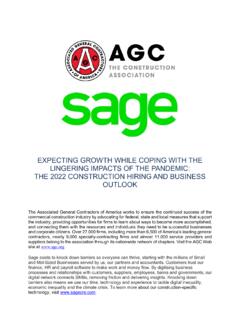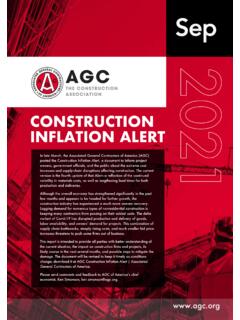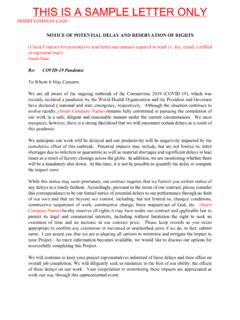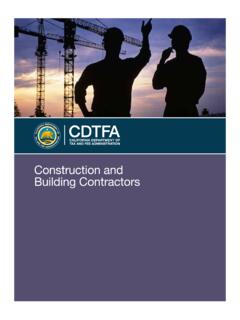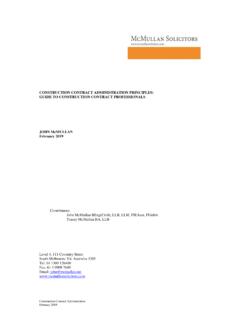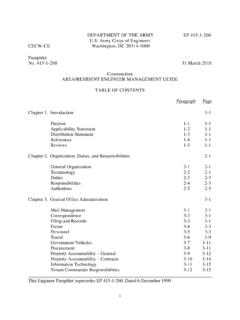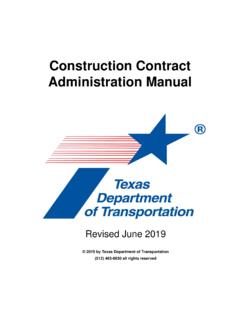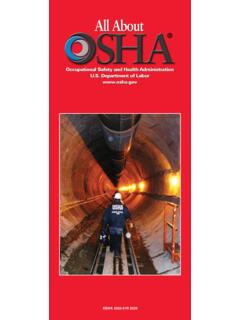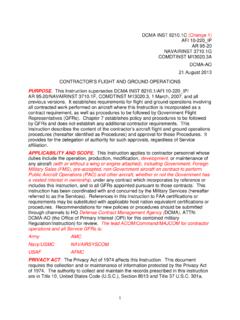Transcription of CONSTRUCTION INFLATION ALERT
1 The CONSTRUCTION industry is currently experiencing an unprecedented mix of steeply rising materials prices, snarled supply chains, and staffing difficulties, combined with slumping demand that is keeping many contractors from passing on their added costs. This combination threatens to push some firms out of business and add to the industry s nearly double-digit unemployment rate. The situation calls for immediate action by federal trade officials to end tariffs and quotas that are adding to price increases and supply shortages. Officials at all levels of government need to identify and remove or lessen any unnecessary or excessive impediments to the importation, domestic production, transport, and delivery of CONSTRUCTION materials and products.
2 Project owners need to recognize how much conditions have changed for projects begun or awarded in the early days of the pandemic or before and to consider providing greater flexibility and cost-sharing. Contractors should become even more vigilant about changes in materials costs and expected delivery dates and should communicate the information promptly to current and prospective clients. This report is intended to provide all parties with better understanding of the current situation, the impact on CONSTRUCTION firms and projects, its likely course in the next several months, and possible steps to mitigate the damage.
3 The document will be revised to keep it timely as conditions change. Please send comments and feedback to AGC of America s chief economist, Ken Simonson, CONSTRUCTION INFLATION ALERT Q1 2021 CONSTRUCTION INFLATION ALERT | 2 Rising costs, flat project pricing Figure 1 illustrates the threat to contractors from fast and steeply rising prices for materials, both for projects that have already been bid or started and for preparing -price or guaranteed-maximum-price bids. The red line shows the change since April 2020 in the price of all materials and services used in nonresidential CONSTRUCTION , while the blue line measures the change or lack of change in what contractors say they would charge to erect a set of nonresidential buildings.
4 This blue line, essentially a measure of bid prices, has remained virtually stable, rising only from April 2020 to February 2021. In contrast, the red line, measuring the cost of contractors purchases, has soared nearly 13% over the same 10 months. In other words, if a contractor or subcontractor submitted a fixed-price bid in April 2020 based on materials costs at that time but did not buy the materials until February 2021, its cost for the materials would have risen an average of nearly 13%. Given that materials often represent half or more of the cost of a contract, such an increase could easily wipe out the profit from a project and create severe financial hardship for the contractor .
5 FIGURE 1 In fact, Figure 1 understates the severity of the current situation for many contractors, in three respects. First, the two lines are calculated from producer price indexes (PPIs) posted monthly by the Bureau of Labor Statistics (BLS). The most recent PPIs are based on prices BLS collected around February 11. Since then, numerous materials have risen even more steeply in price. For instance, the national average retail price of on-highway diesel fuel climbed from $ per gallon on February 8 to $ on March 22, a rise of 1% in just six weeks, according to a weekly truckstop survey posted by the Energy Information administration .
6 Private price-tracking services have reported similarly steep increases for a variety of steel, lumber, and engineered wood products. Input costs for general contractors have soared nearly 13% from April 2020 to February 2021 2021 CONSTRUCTION INFLATION ALERT | 3 Second, contractors are incurring costs not captured by this measure. Delayed deliveries, higher expenditures for personal protective equipment and other sanitation measures, and shortages of employees or subcontractors workers on jobsites due to coronavirus impacts are all driving up contractors costs. In some cases, project completions are being delayed, meaning contractors receive needed payments later and may incur penalties for missed deadlines.
7 Third, many projects or subcontractors packages are heavily weighted toward materials that have risen much more in price than the overall PPI for inputs. As Figure 2 shows, the PPI for diesel fuel (at the fuel terminal, not retail) increased 114% between April 2020 and February 2021. The PPI for lumber and plywood jumped 62%. The index for copper and brass mill shapes climbed 37% and the PPI for steel mill products rose 20%. FIGURE 2 Some broad categories of products have not gone up dramatically, but narrower classes of products within those categories have. For instance, the PPI for plastic CONSTRUCTION products rose only 6% from March 2020 to January.
8 But an AGC member reported on March 5 that for polyvinyl chloride (PVC) used in electric utility work the price from [March 2020] to January 2021 had a general increase of 85%. Following extreme winter weather in Texas that knocked out production facilities and created a surge in demand for pipe to replace broken lines, Now that increase is 270% from March 2020 to March 4, 2021. In recent weeks, producers and distributors of many additional materials have announced large price increases. Some have already been imposed, while others are scheduled to take effect in the next few weeks.
9 For example, a leading producer of spray polyurethane products, used for building sealants and insulation, announced on March 12 that it would increase prices 12-15%, effective for all new and existing orders shipping after April 12. On March 4 another supplier 114% Diesel fuel PPI (Producer Price Index) has increased more than 114% between April 2020 to February 2021 270% Due to extreme weather conditions and general demand, PVC prices have increased over 270% from March 2020 to March 2021 2021 CONSTRUCTION INFLATION ALERT | 4 notified customers of two price increases of 10% each, effective on April 5 and May 1.
10 On March 10, a major building-products distributor announced 19 broad categories of price increases, ranging as high as a 20% increase effective on April 5 for all wallboard and glass mat products. In addition to sudden price increases, contractors are experiencing delivery times that have stretched or become completely unreliable. A producer of building mesh told customers on March 15, Volatility in the costs associated with producing and shipping standard welded wire reinforcement has made it necessary for us to withdraw all previously issued price lists. The availability of SWWR has been negatively impacted by the shortage of raw materials; therefore, lead times previously quoted will require review.
